
Anacamptis pyramidalis, the pyramidal orchid, is a perennial herbaceous plant belonging to the genus Anacamptis of the family Orchidaceae. The scientific name Anacamptis derives from Greek ανακάμτειν 'anakamptein' meaning 'bend forward', while the Latin name pyramidalis refers to the pyramidal form of the inflorescence.

Anacamptis is a genus of flowering plants in the orchid family (Orchidaceae); it is often abbreviated as Ant in horticulture. This genus was established by Louis Claude Richard in 1817; the type species is the pyramidal orchid and it nowadays contains about one-third of the species placed in the "wastebin genus" Orchis before this was split up at the end of the 20th century, among them many that are of hybrid origin. The genus' scientific name is derived from the Greek word anakamptein, meaning "to bend backwards".

Anacamptis morio, the green-winged orchid or green-veined orchid, is a flowering plant of the orchid family, Orchidaceae. It usually has purple flowers, and is found in Europe and the Middle East.

Orchis is a genus in the orchid family (Orchidaceae), occurring mainly in Europe and Northwest Africa, and ranging as far as Tibet, Mongolia, and Xinjiang. The name is from the Ancient Greek ὄρχις orchis, meaning "testicle", from the appearance of the paired subterranean tuberoids.
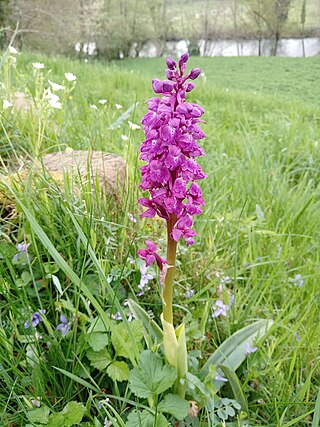
Orchis mascula, the early-purple orchid, early spring orchis, is a species of flowering plant in the orchid family, Orchidaceae.
The Perch is a 72.1 hectare biological Site of Special Scientific Interest close to Cheddar Gorge in the Mendip Hills, Somerset, England. It received SSSI notification in 1990.

Caladenia flava, commonly known as cowslip orchid, is a species of orchid endemic to the south-west of Western Australia. It is a relatively common orchid with a single, hairy leaf and up to three yellow flowers which often have red markings. In 2001 three subspecies were named and a fourth is recognised but not as yet formally described.
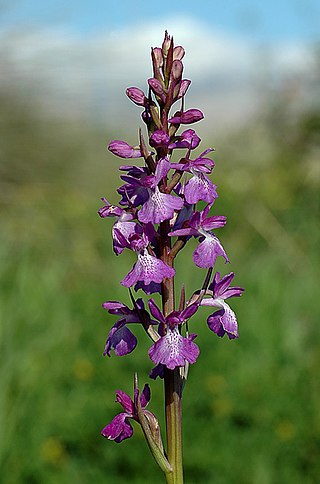
Anacamptis palustris is a species of orchid. It is found in Europe, North Africa and western Asia. This orchid is native to Western and Central Europe, the Mediterranean region, the Balearic Islands, Turkey, Western Asia, Algeria and Tunisia in North Africa, and Saudi Arabia.

Anacamptis morio subsp. syriaca is a subspecies of orchid. It has been found in Turkey and Lebanon.
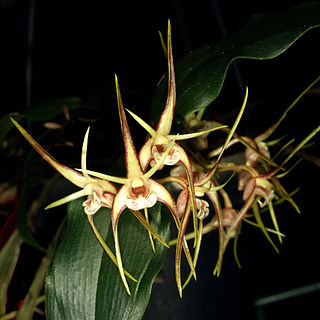
Dendrobium tetragonum, commonly known as the tree spider orchid, is a variable species of epiphytic or lithophytic orchid endemic to eastern Australia. Tree spider orchids are unusual in having pendulous pseudobulbs that are thin and wiry near the base then expand into a fleshy, four-sided upper section before tapering at the tip. There are only a few thin but leathery leaves at the end of the pseudobulbs and up to five flowers on relatively short flowering stems. To allow for the variations in the species there are five subspecies and a variety, some with a unique common name.

Monewden Meadows is a 3.7-hectare (9.1-acre) biological Site of Special Scientific Interest south-west of Monewden in Suffolk. It is a Nature Conservation Review site, Grade I, and it is managed by the Suffolk Wildlife Trust under the name Martins' Meadows.

The natural history of the island of Rhodes is determined by its geographic position, climate and geological diversity. Rhodes is in the Eastern Mediterranean Basin close to the coast of Turkey, and the flora and fauna are a mixture of Mediterranean and Asian elements. Rhodes is in the Eastern Mediterranean conifer-sclerophyllous-broadleaf forests ecoregion.

Dactylorhiza majalis subsp. traunsteinerioides, known as the narrow-leaved marsh-orchid and Pugsley's marsh orchid, is a subspecies of Dactylorhiza majalis found only in Britain and Ireland. It is also treated as the species Dactylorhiza traunsteinerioides.
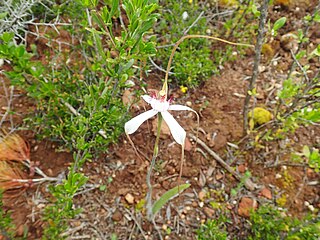
Caladenia longicauda subsp. clivicola, commonly known as the Darling Scarp white spider orchid, or hills white spider orchid is a plant in the orchid family Orchidaceae and is endemic to the south-west of Western Australia. It has a single hairy leaf and up to three mostly white flowers with long, drooping lateral sepals and petals, a relatively small, narrow labellum and narrow labellum teeth. It grows in a restricted area, mostly on the Darling Scarp.

Caladenia longicauda subsp. crassa, commonly known as the Esperance white spider orchid, is a plant in the orchid family Orchidaceae and is endemic to the south-west of Western Australia. It has a single hairy leaf and up to three mostly white flowers with long, broad, spreading lateral sepals and petals, a relatively broad labellum with short, narrow teeth. It grows on the south coast between Bremer Bay and the Cape Arid National Park.
Caladenia longicauda subsp. minima, commonly known as the little white spider orchid, is a plant in the orchid family Orchidaceae and is endemic to the south-west of Western Australia. It has a single hairy leaf and up to three mainly white flowers with long, drooping lateral sepals and petals. It is a relatively rare orchid which is similar to the daddy-long-legs spider orchid but has smaller flowers and a more easterly distribution.

Caladenia remota subsp. parva, commonly known as the Perenjori spider orchid, is a plant in the orchid family Orchidaceae and is endemic to the south-west of Western Australia. It has a single hairy leaf and up to three creamy-white to pale yellow flowers. It has a more restricted and more westerly distribution than subspecies remota.
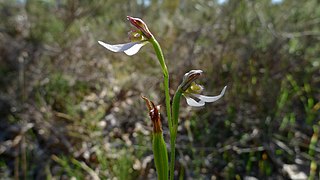
Eriochilus dilatatus, commonly known as the white bunny orchid, is a plant in the orchid family Orchidaceae and is endemic to Western Australia. It is a common and widespread, slender ground orchid with a single leaf and up to fifteen small white and greenish flowers with reddish or brownish markings and a hairy labellum.
















